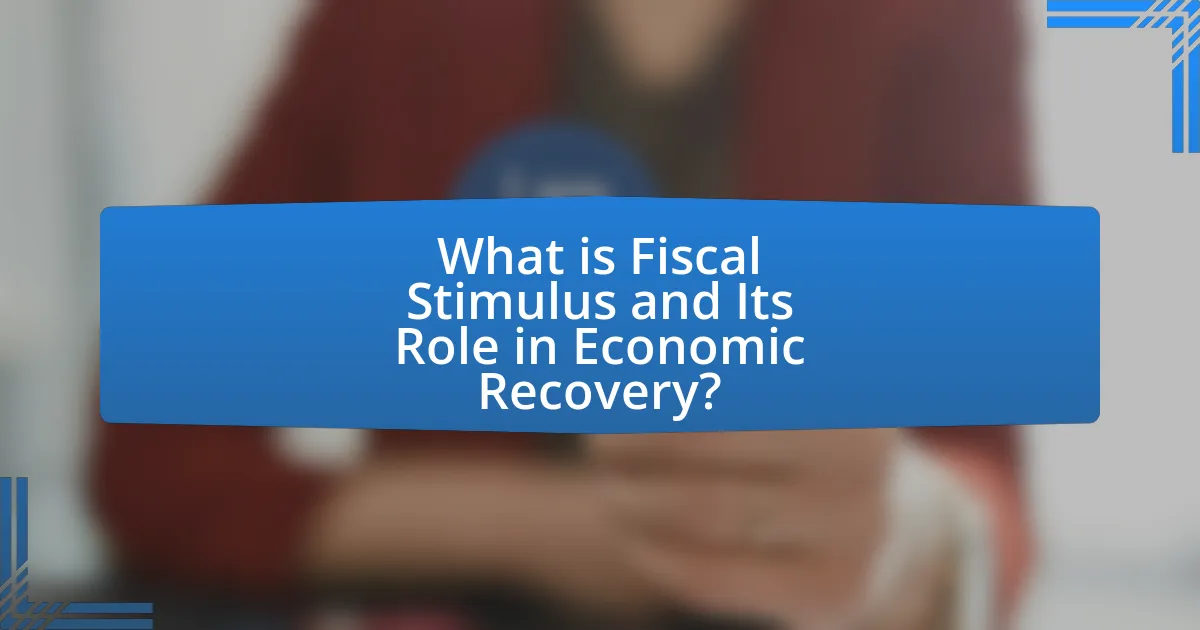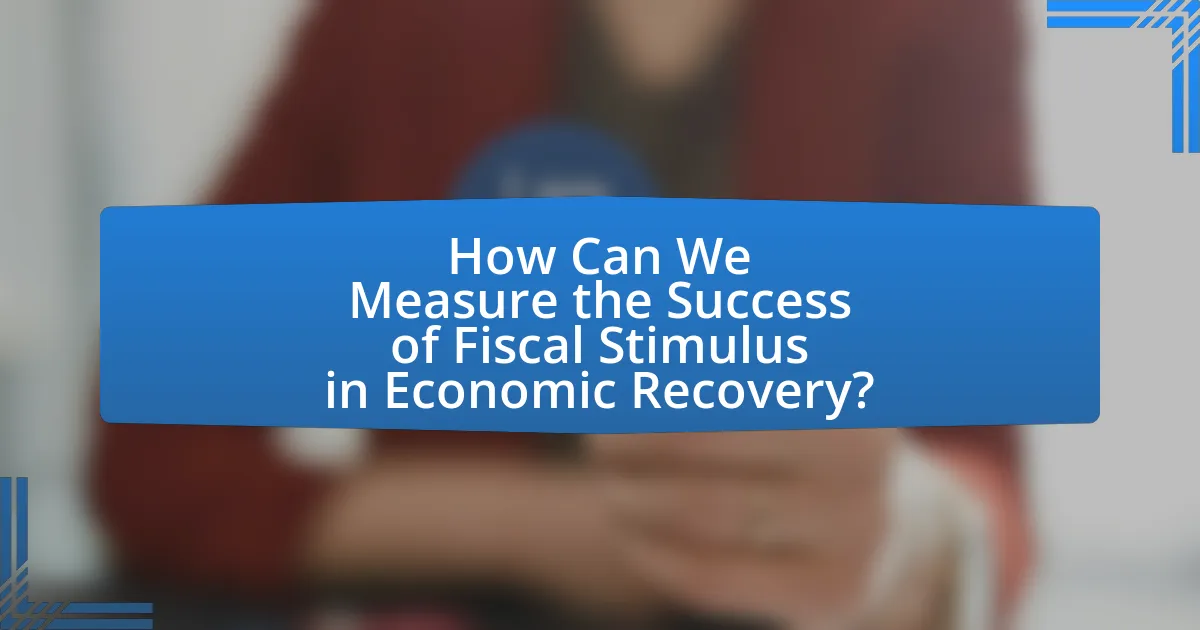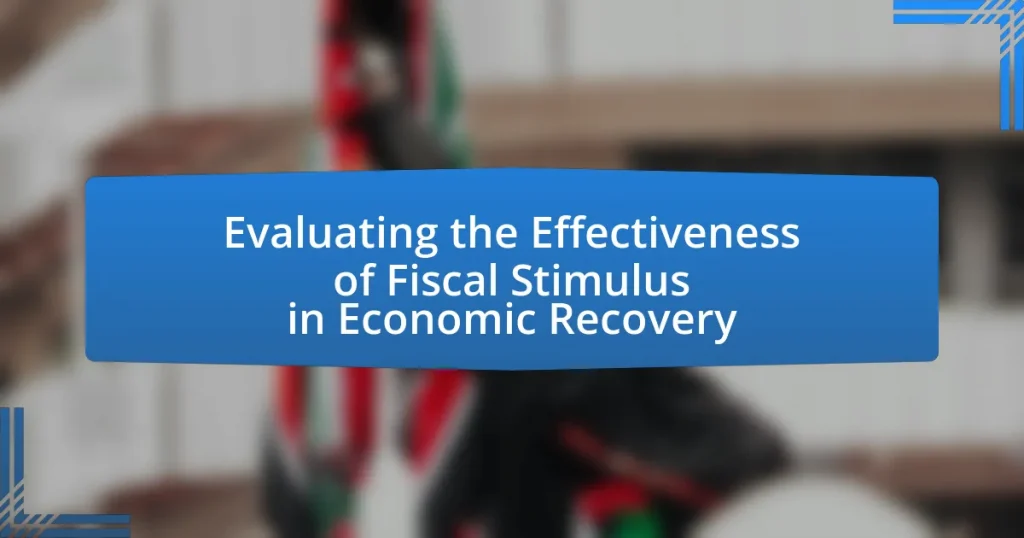Fiscal stimulus refers to government actions, such as increased public spending and tax cuts, aimed at enhancing economic activity during downturns. This article evaluates the effectiveness of fiscal stimulus in promoting economic recovery, highlighting its role in boosting demand, creating jobs, and facilitating quicker rebounds from recessions. Key components of fiscal stimulus, including government spending, tax cuts, and transfer payments, are examined alongside their interactions and impacts on economic health. Historical examples, such as the New Deal and the American Recovery and Reinvestment Act, illustrate the significance of timely and targeted fiscal measures. The article also discusses the metrics used to assess fiscal stimulus effectiveness and the factors influencing its outcomes, providing insights for policymakers to enhance future interventions.

What is Fiscal Stimulus and Its Role in Economic Recovery?
Fiscal stimulus refers to government measures, typically involving increased public spending and tax cuts, aimed at boosting economic activity during periods of downturn. Its role in economic recovery is significant, as it injects liquidity into the economy, stimulates demand, and creates jobs, thereby facilitating a quicker rebound from recessions. Historical evidence, such as the 2008 financial crisis, demonstrates that countries implementing fiscal stimulus measures, like the American Recovery and Reinvestment Act, experienced faster economic recovery compared to those that did not.
How does fiscal stimulus function in an economy?
Fiscal stimulus functions in an economy by increasing government spending or reducing taxes to boost aggregate demand. This increase in demand leads to higher consumption and investment, which can stimulate economic growth, particularly during periods of recession or economic downturn. For example, during the 2008 financial crisis, the U.S. government implemented the American Recovery and Reinvestment Act, which allocated approximately $831 billion to stimulate the economy, resulting in a significant increase in GDP and job creation. Studies, such as those conducted by the Congressional Budget Office, have shown that fiscal stimulus can effectively reduce unemployment and promote economic recovery when implemented timely and adequately.
What are the key components of fiscal stimulus?
The key components of fiscal stimulus are government spending, tax cuts, and transfer payments. Government spending involves direct expenditures on goods and services to boost economic activity, such as infrastructure projects, which can create jobs and stimulate demand. Tax cuts increase disposable income for individuals and businesses, encouraging consumption and investment. Transfer payments, such as unemployment benefits and social security, provide financial support to those in need, helping to maintain consumer spending during economic downturns. These components work together to enhance overall economic activity and support recovery during recessions.
How do these components interact to promote recovery?
Fiscal stimulus components, such as government spending, tax cuts, and monetary policy adjustments, interact synergistically to promote economic recovery. Government spending injects immediate funds into the economy, creating jobs and increasing demand for goods and services. Tax cuts enhance disposable income for consumers and businesses, further stimulating spending and investment. Monetary policy adjustments, like lowering interest rates, make borrowing cheaper, encouraging both consumer spending and business investment.
Research by the International Monetary Fund indicates that coordinated fiscal and monetary policies can significantly boost GDP growth during economic downturns, demonstrating the effectiveness of these components working together. For instance, during the 2008 financial crisis, countries that implemented aggressive fiscal stimulus measures experienced faster recoveries compared to those that did not. This evidence supports the conclusion that the interaction of these components is crucial for effective economic recovery.
Why is evaluating fiscal stimulus important for economic recovery?
Evaluating fiscal stimulus is important for economic recovery because it assesses the effectiveness of government spending and tax policies in revitalizing economic activity. By analyzing the impact of fiscal measures, policymakers can determine which strategies successfully stimulate growth, reduce unemployment, and increase consumer spending. For instance, during the 2008 financial crisis, the American Recovery and Reinvestment Act led to an estimated increase in GDP by 2.5% to 3.5% and created or saved approximately 2.5 million jobs, demonstrating the critical role of effective fiscal stimulus in recovery efforts. This evaluation process ensures that resources are allocated efficiently and informs future policy decisions to enhance economic resilience.
What metrics are used to assess the effectiveness of fiscal stimulus?
Metrics used to assess the effectiveness of fiscal stimulus include GDP growth, unemployment rates, inflation rates, and consumer spending. GDP growth measures the overall economic output and indicates whether the stimulus has spurred economic activity. Unemployment rates reflect job creation and labor market recovery, showing the impact of fiscal measures on employment. Inflation rates help evaluate whether stimulus spending has led to price increases, which can indicate overheating in the economy. Consumer spending, as a key component of GDP, assesses how fiscal stimulus influences household consumption patterns. These metrics provide a comprehensive view of the economic impact of fiscal stimulus initiatives.
How do these metrics reflect economic health?
Economic health is reflected through metrics such as GDP growth, unemployment rates, and inflation levels. These indicators provide a comprehensive view of an economy’s performance; for instance, a rising GDP indicates increased economic activity and productivity, while low unemployment rates suggest that more individuals are gainfully employed, contributing to consumer spending and overall economic stability. Conversely, high inflation can erode purchasing power, signaling potential economic distress. Historical data supports this; for example, during the post-2008 financial crisis, GDP growth rates and declining unemployment were key metrics used to assess recovery, demonstrating their critical role in evaluating economic health.
What historical examples illustrate the impact of fiscal stimulus?
The New Deal in the United States during the Great Depression is a historical example that illustrates the impact of fiscal stimulus. Implemented by President Franklin D. Roosevelt from 1933 to 1939, the New Deal involved significant government spending on public works, infrastructure, and social programs, which aimed to revive the economy. This fiscal stimulus led to a reduction in unemployment from approximately 25% in 1933 to about 14% by 1937, demonstrating its effectiveness in economic recovery. Another example is the 2008 American Recovery and Reinvestment Act, which allocated $787 billion to stimulate the economy following the financial crisis. Studies indicate that this fiscal stimulus contributed to the creation of approximately 3.5 million jobs and helped to stabilize the economy, showcasing the positive effects of government intervention during economic downturns.
What lessons can be learned from past fiscal stimulus measures?
Past fiscal stimulus measures demonstrate that timely and targeted interventions can effectively mitigate economic downturns. For instance, the American Recovery and Reinvestment Act of 2009, implemented during the Great Recession, resulted in a GDP increase of approximately 2.5% and created or saved around 3.5 million jobs, according to the Congressional Budget Office. Additionally, the effectiveness of fiscal stimulus is enhanced when it includes direct support to households, as seen in the 2020 COVID-19 relief packages, which provided immediate financial assistance and contributed to a quicker economic rebound. These examples illustrate that well-structured fiscal policies can lead to significant positive outcomes in economic recovery.
How did these measures influence subsequent economic policies?
Fiscal stimulus measures significantly influenced subsequent economic policies by establishing a precedent for government intervention during economic downturns. These measures demonstrated that targeted fiscal actions, such as increased government spending and tax cuts, could effectively stimulate demand and promote recovery. For instance, the fiscal stimulus implemented during the 2008 financial crisis led to the adoption of similar strategies in response to the COVID-19 pandemic, where governments worldwide enacted substantial stimulus packages to mitigate economic impacts. This historical context illustrates that successful fiscal interventions have shaped policymakers’ approaches, reinforcing the belief in proactive fiscal measures as essential tools for economic stabilization and recovery.

What Factors Influence the Effectiveness of Fiscal Stimulus?
The effectiveness of fiscal stimulus is influenced by several key factors, including the timing of implementation, the size of the stimulus, the type of spending, and the economic context. Timely fiscal stimulus can mitigate economic downturns, as evidenced by the rapid response during the 2008 financial crisis, where timely measures helped stabilize the economy. The size of the stimulus also matters; larger fiscal injections tend to have a more pronounced impact on economic activity, as shown by studies indicating that a 1% increase in government spending can lead to a 0.5% increase in GDP. Additionally, the type of spending—whether it is targeted towards infrastructure, social programs, or tax cuts—affects its multiplier effect, with infrastructure spending generally yielding higher returns. Lastly, the prevailing economic conditions, such as consumer confidence and existing monetary policy, can either enhance or dampen the impact of fiscal measures, as seen during the COVID-19 pandemic when low interest rates amplified the effects of fiscal interventions.
How do economic conditions affect fiscal stimulus outcomes?
Economic conditions significantly influence fiscal stimulus outcomes by determining the effectiveness and efficiency of government spending. In periods of economic downturn, such as recessions, fiscal stimulus can lead to increased consumer spending and investment, as evidenced by the 2008 financial crisis when stimulus measures like the American Recovery and Reinvestment Act resulted in a GDP growth of approximately 2.5% in the following years. Conversely, in a robust economy, fiscal stimulus may lead to inflationary pressures rather than increased output, as seen in the post-pandemic recovery phase where stimulus measures contributed to rising prices without a corresponding increase in economic growth. Thus, the prevailing economic conditions shape how fiscal stimulus is absorbed and its ultimate impact on recovery.
What role does consumer confidence play in the effectiveness of fiscal stimulus?
Consumer confidence significantly influences the effectiveness of fiscal stimulus by determining the extent to which individuals are willing to spend the additional income provided by government measures. When consumer confidence is high, people are more likely to increase their consumption, thereby amplifying the impact of fiscal stimulus on economic growth. For instance, during the 2008 financial crisis, research indicated that higher consumer confidence correlated with increased spending, which in turn enhanced the effectiveness of stimulus packages like the American Recovery and Reinvestment Act. Conversely, low consumer confidence can lead to reduced spending, diminishing the intended effects of fiscal stimulus initiatives.
How do unemployment rates impact the success of fiscal stimulus measures?
Unemployment rates significantly impact the success of fiscal stimulus measures by influencing consumer spending and overall economic activity. High unemployment rates typically lead to decreased disposable income, which reduces consumer demand for goods and services. For instance, during the 2008 financial crisis, the U.S. unemployment rate peaked at 10%, and despite substantial fiscal stimulus efforts, the recovery was slow due to weakened consumer confidence and spending. Conversely, lower unemployment rates can enhance the effectiveness of fiscal stimulus, as more individuals have jobs and income to spend, thereby amplifying the intended economic boost from such measures. Historical data shows that countries with lower unemployment rates tend to experience quicker recoveries following fiscal interventions, as seen in various economic analyses post-recession.
What types of fiscal stimulus are most effective in different scenarios?
Direct cash transfers are most effective in scenarios of immediate economic distress, such as during a recession. These transfers provide households with liquidity, enabling them to maintain consumption levels, which is crucial for stabilizing demand. For instance, during the COVID-19 pandemic, the U.S. government issued stimulus checks that resulted in a significant increase in consumer spending, with research indicating that approximately 70% of recipients used the funds for essential expenses.
Targeted tax cuts are effective in stimulating investment and job creation in specific sectors, particularly during periods of slow growth. For example, the 2008 Economic Stimulus Act included tax incentives for businesses, which helped to spur investment in capital goods and contributed to economic recovery.
Infrastructure spending is particularly effective in long-term recovery scenarios, as it creates jobs and enhances productivity. Historical data shows that every dollar spent on infrastructure can generate approximately $1.50 in economic output, as seen in the American Recovery and Reinvestment Act of 2009, which aimed to revitalize the economy through significant public works projects.
In summary, direct cash transfers are best for immediate relief, targeted tax cuts for sector-specific growth, and infrastructure spending for long-term recovery. Each type of fiscal stimulus serves distinct purposes based on the economic context.
What are the differences between direct payments and tax cuts as forms of stimulus?
Direct payments and tax cuts differ primarily in their mechanisms and immediate impacts on consumers. Direct payments provide individuals with cash transfers, which can quickly increase disposable income and stimulate spending. For example, during the COVID-19 pandemic, the U.S. government issued stimulus checks that directly boosted consumer spending, contributing to economic recovery. In contrast, tax cuts reduce the amount of tax individuals owe, which may lead to increased disposable income over time but often requires individuals to wait until tax filing to realize the benefits. Historical data shows that direct payments tend to have a more immediate effect on consumer behavior compared to tax cuts, which may take longer to influence spending patterns.
How do infrastructure investments compare to social welfare programs in terms of recovery impact?
Infrastructure investments generally have a more substantial long-term recovery impact compared to social welfare programs. Infrastructure projects, such as roads, bridges, and public transit systems, create jobs, stimulate economic activity, and enhance productivity by improving connectivity and efficiency. For instance, a study by the American Society of Civil Engineers found that every $1 billion invested in infrastructure generates approximately 13,000 jobs and can lead to a $3.7 billion increase in GDP over time. In contrast, social welfare programs primarily provide immediate financial relief to individuals, which can help stabilize consumption but may not lead to significant long-term economic growth. Research from the National Bureau of Economic Research indicates that while social welfare programs are crucial for short-term support, their impact on overall economic recovery is less pronounced than that of infrastructure investments.
What challenges arise in implementing fiscal stimulus?
Implementing fiscal stimulus faces several challenges, including timing, political constraints, and effectiveness in targeting. Timing is critical; delays in enacting stimulus measures can result in missed opportunities to address economic downturns, as seen during the 2008 financial crisis when delayed responses hindered recovery. Political constraints often arise from differing ideologies among lawmakers, which can lead to gridlock and prevent timely implementation of necessary measures. Additionally, the effectiveness of fiscal stimulus can be compromised if funds are not directed toward sectors that will generate the most economic activity, as evidenced by studies showing that targeted spending, such as infrastructure investment, yields higher multipliers compared to broad tax cuts.
How do political factors influence the design and execution of fiscal stimulus?
Political factors significantly influence the design and execution of fiscal stimulus by shaping policy priorities, funding allocations, and the overall approach to economic intervention. For instance, the political ideology of governing parties often dictates whether stimulus measures focus on tax cuts or increased government spending. In the United States, the 2009 American Recovery and Reinvestment Act, driven by a Democratic administration, emphasized public investment and social programs, while Republican-led initiatives typically prioritize tax incentives. Additionally, political stability and public opinion can affect the timing and scale of stimulus measures; during economic downturns, governments may rush to implement stimulus to maintain voter support, as seen in response to the COVID-19 pandemic. Historical data shows that countries with cohesive political environments tend to execute more effective fiscal stimulus, as seen in Germany’s swift response during the 2008 financial crisis, which was facilitated by a stable coalition government.
What are the potential risks associated with excessive fiscal stimulus?
Excessive fiscal stimulus can lead to significant economic risks, including inflation, increased public debt, and potential crowding out of private investment. Inflation occurs when demand outpaces supply, as seen in various economies post-stimulus, leading to rising prices. For instance, the U.S. experienced a notable inflation spike in 2021, attributed to expansive fiscal measures during the COVID-19 pandemic. Increased public debt results from financing large stimulus packages, which can burden future generations and lead to higher interest rates. The International Monetary Fund (IMF) has warned that excessive debt levels can hinder economic growth. Additionally, crowding out happens when government borrowing drives up interest rates, making it more expensive for businesses to invest. Historical examples, such as Japan in the 1990s, illustrate how prolonged fiscal stimulus without structural reforms can stagnate economic growth.

How Can We Measure the Success of Fiscal Stimulus in Economic Recovery?
The success of fiscal stimulus in economic recovery can be measured through indicators such as GDP growth, unemployment rates, and consumer spending. For instance, after the implementation of the American Recovery and Reinvestment Act in 2009, the U.S. experienced a GDP growth rate increase from -2.5% in 2009 to 2.6% in 2010, demonstrating a positive impact on economic activity. Additionally, unemployment rates fell from a peak of 10% in October 2009 to 4.7% by the end of 2016, indicating improved labor market conditions. Furthermore, consumer spending, which accounts for a significant portion of GDP, rose by 3.8% in 2010, reflecting increased confidence among consumers. These metrics provide concrete evidence of the effectiveness of fiscal stimulus in facilitating economic recovery.
What indicators signal the success of fiscal stimulus measures?
Indicators that signal the success of fiscal stimulus measures include increased GDP growth, reduced unemployment rates, and improved consumer spending. For instance, following the implementation of the American Recovery and Reinvestment Act in 2009, the U.S. experienced a GDP growth rate increase from -2.5% in 2009 to 2.6% in 2010, demonstrating a positive economic response. Additionally, unemployment rates fell from 10% in October 2009 to 4.7% by December 2016, indicating job creation and economic recovery. Consumer spending also rose significantly, with a reported increase of 4.2% in 2010, reflecting enhanced consumer confidence and economic activity. These metrics collectively provide a clear assessment of the effectiveness of fiscal stimulus measures in promoting economic recovery.
How do GDP growth rates reflect the effectiveness of fiscal stimulus?
GDP growth rates serve as a primary indicator of the effectiveness of fiscal stimulus by demonstrating the impact of government spending and tax policies on economic activity. When fiscal stimulus is implemented, such as increased government spending or tax cuts, it is expected to boost aggregate demand, leading to higher GDP growth. For instance, during the 2008 financial crisis, the U.S. implemented the American Recovery and Reinvestment Act, which resulted in a GDP growth increase of approximately 4.1% in 2010, indicating a positive response to the stimulus measures. This correlation between fiscal stimulus and GDP growth rates provides empirical evidence that effective fiscal policies can stimulate economic recovery and enhance overall economic performance.
What role do employment rates play in evaluating fiscal stimulus success?
Employment rates are a critical indicator in evaluating the success of fiscal stimulus measures. High employment rates typically signify that fiscal stimulus has effectively boosted economic activity, leading to job creation and reduced unemployment. For instance, during the implementation of the American Recovery and Reinvestment Act in 2009, the U.S. saw a significant increase in employment rates, which correlated with the stimulus package’s goal of job preservation and creation. This relationship demonstrates that rising employment rates can validate the effectiveness of fiscal policies aimed at economic recovery.
How can policymakers improve the effectiveness of future fiscal stimulus?
Policymakers can improve the effectiveness of future fiscal stimulus by ensuring timely and targeted interventions that address specific economic needs. Timeliness is crucial; for instance, the rapid deployment of stimulus checks during the COVID-19 pandemic helped to stabilize consumer spending, which is vital for economic recovery. Targeting is equally important; research shows that directing funds to lower-income households, who are more likely to spend the money quickly, can amplify the stimulus effect. According to a study by the National Bureau of Economic Research, targeted cash transfers can lead to a more significant increase in consumption compared to broad-based tax cuts. Additionally, incorporating automatic stabilizers, such as unemployment benefits that adjust based on economic conditions, can provide ongoing support without the need for new legislation.
What best practices should be adopted based on past evaluations?
Best practices based on past evaluations of fiscal stimulus effectiveness include implementing timely and targeted interventions, ensuring transparency in fund allocation, and monitoring outcomes rigorously. Timely interventions, such as those executed during the 2008 financial crisis, demonstrated that quick responses can mitigate economic downturns effectively. Targeted measures, like direct payments to low-income households, have shown to stimulate consumer spending more efficiently than broad tax cuts, as evidenced by studies from the National Bureau of Economic Research. Transparency in fund allocation fosters public trust and accountability, which is crucial for the success of stimulus programs. Rigorous monitoring and evaluation of outcomes, as practiced in various OECD countries, allow for adjustments in real-time and inform future policy decisions.
How can data analytics enhance the assessment of fiscal stimulus measures?
Data analytics can enhance the assessment of fiscal stimulus measures by providing real-time insights into economic indicators and the effectiveness of policy interventions. By analyzing large datasets, such as employment rates, consumer spending, and business activity, analysts can identify trends and measure the direct impact of stimulus measures on economic recovery. For instance, a study by the National Bureau of Economic Research found that targeted fiscal stimulus led to a 1.5% increase in GDP within a year of implementation, demonstrating the utility of data analytics in quantifying economic outcomes. This analytical approach allows policymakers to adjust strategies based on empirical evidence, ensuring that fiscal measures are effectively tailored to meet economic needs.
What practical steps can be taken to ensure effective fiscal stimulus implementation?
To ensure effective fiscal stimulus implementation, governments should prioritize timely disbursement of funds, targeted support to vulnerable sectors, and continuous monitoring of economic impacts. Timely disbursement is crucial as delays can diminish the stimulus effect; for instance, the U.S. CARES Act in 2020 demonstrated that rapid distribution of funds led to quicker economic recovery. Targeted support ensures that resources are allocated to sectors most affected by economic downturns, such as hospitality and retail, which can maximize the impact of the stimulus. Continuous monitoring allows for adjustments based on real-time economic data, enhancing the effectiveness of the stimulus measures. Historical examples, such as the swift response during the 2008 financial crisis, highlight the importance of these steps in achieving desired economic outcomes.
How can stakeholder engagement improve fiscal stimulus outcomes?
Stakeholder engagement can improve fiscal stimulus outcomes by ensuring that the needs and perspectives of various groups are considered in the design and implementation of stimulus measures. Engaging stakeholders, such as businesses, community organizations, and local governments, allows for the identification of specific economic challenges and opportunities, leading to more targeted and effective interventions. For instance, research by the International Monetary Fund indicates that countries with higher levels of stakeholder consultation during fiscal policy formulation tend to experience better economic recovery outcomes, as these policies are more likely to address the actual needs of the economy. This alignment between policy and stakeholder needs enhances the efficiency of resource allocation and increases public support for stimulus measures, ultimately leading to improved economic performance.
What strategies can be employed to monitor and adjust fiscal stimulus in real-time?
Real-time monitoring and adjustment of fiscal stimulus can be achieved through data analytics, economic indicators, and feedback mechanisms. Utilizing advanced data analytics allows policymakers to assess the immediate impacts of fiscal measures by analyzing real-time economic data, such as employment rates, consumer spending, and business activity. Economic indicators, including GDP growth and inflation rates, provide essential insights into the effectiveness of stimulus measures, enabling timely adjustments. Feedback mechanisms, such as surveys and public consultations, gather stakeholder input, ensuring that fiscal policies remain responsive to changing economic conditions. Historical examples, such as the rapid adjustments made during the 2008 financial crisis, demonstrate the importance of these strategies in effectively managing fiscal stimulus.


